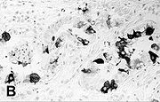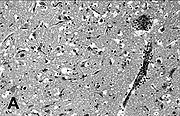
Phocine distemper virus
Encyclopedia
Phocine distemper virus (PDV) is a paramyxovirus
of the genus morbillivirus
that is pathogenic for pinniped
species, particularly seals. Clinical signs include laboured breathing, fever and nervous symptoms.
PDV was first identified in 1988 as the cause of death of 18,000 harbour seals (Phoca vitulina) and 300 grey seals (Halichoerus grypus) along the northern European coast.
In the same year, two more outbreaks of viral disease in aquatic mammals were observed. Another Morbillivirus caused the deaths of Baikal seals (Phoca sibirica) in Lake Baikal
, Siberia
. This was later identified as a strain of the closely related canine distemper virus (CDV) and was probably transmitted to the seals from terrestrial animals, CDV being widespread in canines
in the Lake Baikal region.
The third outbreak occurred in harbour porpoises (Phocoena phocoena) near the British Isles
and the Netherlands
. A third Morbillivirus, named porpoise morbillivirus was identified as the cause.
In 2002, an epidemic of PDV along the North Sea
coast resulted in the deaths of 21,700 seals, estimated to be 51% of the population.
 Antibodies
Antibodies
to PDV and CDV have been found in a number of carnivorous mammal species in Canada
, including polar bears, indicating the potential for the viruses to spread to new species.
The suddenness of the emergence of PDV and related viruses in aquatic mammals has implicated environmental changes as the cause. Pollutants have been posited as contributors by interfering with the ability of animals to mount a defense against infection. Alternatively, climate change
and overfishing may have forced aquatic species that naturally harbour the viruses into new areas, exposing immunologically naïve populations.
Paramyxovirus
Paramyxoviruses are viruses of the Paramyxoviridae family of the Mononegavirales order; they are negative-sense single-stranded RNA viruses responsible for a number of human and animal diseases.-Genera:*Subfamily Paramyxovirinae**Genus Avulavirus Paramyxoviruses (from Greek para-, beyond, -myxo-,...
of the genus morbillivirus
Morbillivirus
Morbillivirus is a genus belonging to the Paramyxoviridae family of viruses in the order Mononegavirales. Many members of the genus cause diseases, such as rinderpest and measles, and are highly infectious.- External links :* *...
that is pathogenic for pinniped
Pinniped
Pinnipeds or fin-footed mammals are a widely distributed and diverse group of semiaquatic marine mammals comprising the families Odobenidae , Otariidae , and Phocidae .-Overview: Pinnipeds are typically sleek-bodied and barrel-shaped...
species, particularly seals. Clinical signs include laboured breathing, fever and nervous symptoms.
PDV was first identified in 1988 as the cause of death of 18,000 harbour seals (Phoca vitulina) and 300 grey seals (Halichoerus grypus) along the northern European coast.
In the same year, two more outbreaks of viral disease in aquatic mammals were observed. Another Morbillivirus caused the deaths of Baikal seals (Phoca sibirica) in Lake Baikal
Lake Baikal
Lake Baikal is the world's oldest at 30 million years old and deepest lake with an average depth of 744.4 metres.Located in the south of the Russian region of Siberia, between Irkutsk Oblast to the northwest and the Buryat Republic to the southeast, it is the most voluminous freshwater lake in the...
, Siberia
Siberia
Siberia is an extensive region constituting almost all of Northern Asia. Comprising the central and eastern portion of the Russian Federation, it was part of the Soviet Union from its beginning, as its predecessor states, the Tsardom of Russia and the Russian Empire, conquered it during the 16th...
. This was later identified as a strain of the closely related canine distemper virus (CDV) and was probably transmitted to the seals from terrestrial animals, CDV being widespread in canines
Dog
The domestic dog is a domesticated form of the gray wolf, a member of the Canidae family of the order Carnivora. The term is used for both feral and pet varieties. The dog may have been the first animal to be domesticated, and has been the most widely kept working, hunting, and companion animal in...
in the Lake Baikal region.
The third outbreak occurred in harbour porpoises (Phocoena phocoena) near the British Isles
British Isles
The British Isles are a group of islands off the northwest coast of continental Europe that include the islands of Great Britain and Ireland and over six thousand smaller isles. There are two sovereign states located on the islands: the United Kingdom of Great Britain and Northern Ireland and...
and the Netherlands
Netherlands
The Netherlands is a constituent country of the Kingdom of the Netherlands, located mainly in North-West Europe and with several islands in the Caribbean. Mainland Netherlands borders the North Sea to the north and west, Belgium to the south, and Germany to the east, and shares maritime borders...
. A third Morbillivirus, named porpoise morbillivirus was identified as the cause.
In 2002, an epidemic of PDV along the North Sea
North Sea
In the southwest, beyond the Straits of Dover, the North Sea becomes the English Channel connecting to the Atlantic Ocean. In the east, it connects to the Baltic Sea via the Skagerrak and Kattegat, narrow straits that separate Denmark from Norway and Sweden respectively...
coast resulted in the deaths of 21,700 seals, estimated to be 51% of the population.

Antibody
An antibody, also known as an immunoglobulin, is a large Y-shaped protein used by the immune system to identify and neutralize foreign objects such as bacteria and viruses. The antibody recognizes a unique part of the foreign target, termed an antigen...
to PDV and CDV have been found in a number of carnivorous mammal species in Canada
Canada
Canada is a North American country consisting of ten provinces and three territories. Located in the northern part of the continent, it extends from the Atlantic Ocean in the east to the Pacific Ocean in the west, and northward into the Arctic Ocean...
, including polar bears, indicating the potential for the viruses to spread to new species.
The suddenness of the emergence of PDV and related viruses in aquatic mammals has implicated environmental changes as the cause. Pollutants have been posited as contributors by interfering with the ability of animals to mount a defense against infection. Alternatively, climate change
Climate change
Climate change is a significant and lasting change in the statistical distribution of weather patterns over periods ranging from decades to millions of years. It may be a change in average weather conditions or the distribution of events around that average...
and overfishing may have forced aquatic species that naturally harbour the viruses into new areas, exposing immunologically naïve populations.

